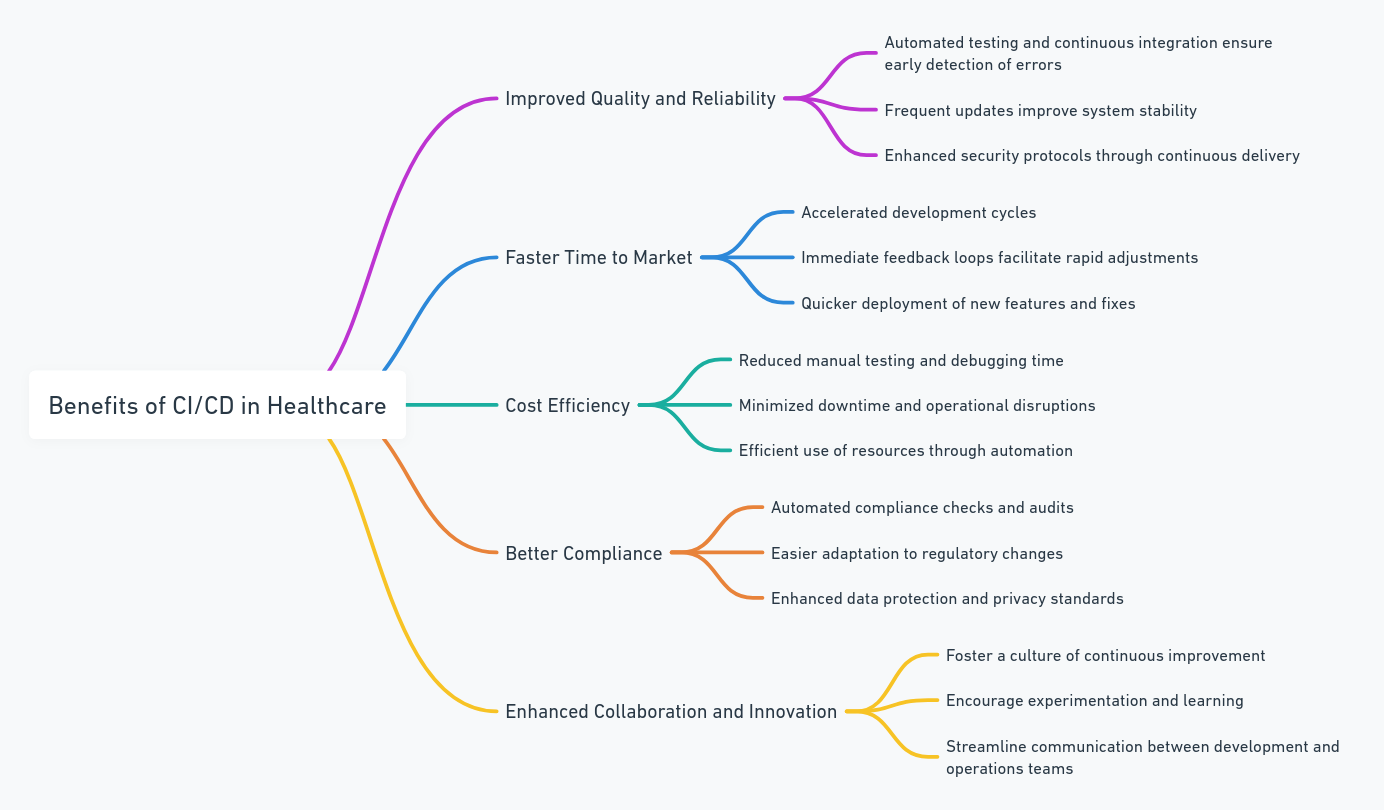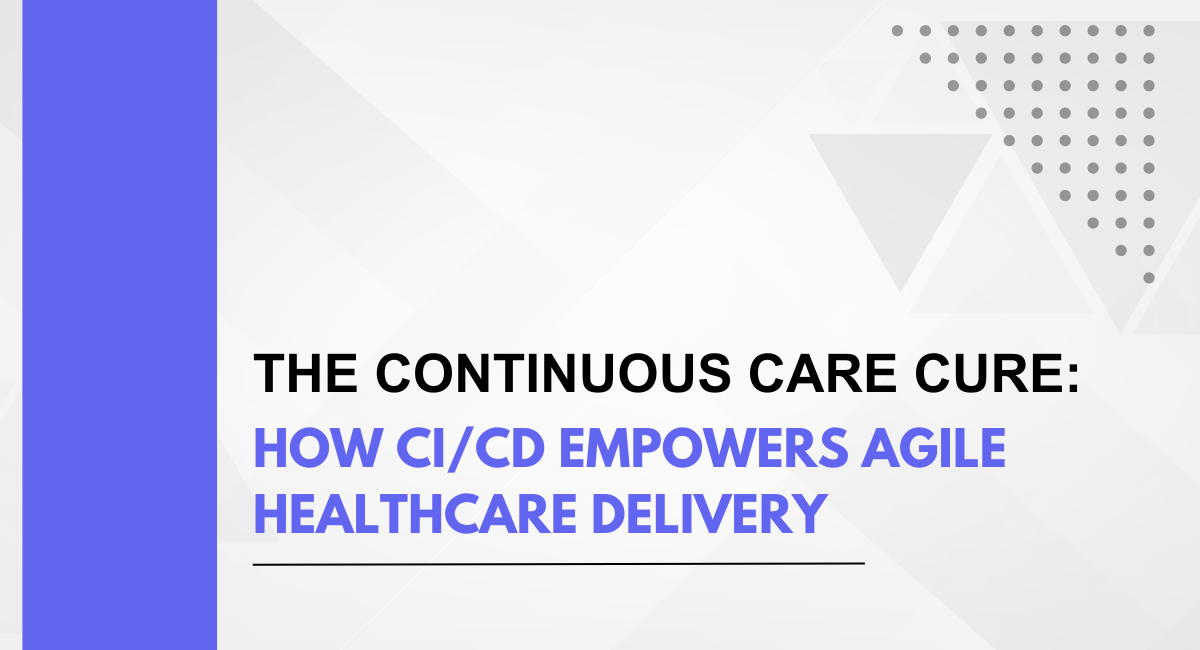Continuous Integration (CI) and Continuous Delivery (CD) are software development practices that aim to enhance the efficiency and reliability of the development and deployment processes.
CI involves frequently integrating code changes into a shared repository, enabling automated testing to detect and address integration issues early in the development lifecycle. CD extends CI by automating the entire delivery process, ensuring that software can be released quickly and reliably.
The market size for Medical Device Software Testing Services was USD 10.7 Billion in 2023 and is projected to attain USD 20.5 Billion by the conclusion of 2030, exhibiting a Compound Annual Growth Rate (CAGR) of 9.9% during the forecast period spanning from 2023 to 2030.
Understanding CI/CD in Healthcare
Continuous Integration (CI) involves frequently integrating code changes from multiple contributors into a shared repository. Automated builds and tests are triggered with each integration to detect and address issues early in the development process.
Continuous Delivery (CD) extends CI by automating the entire process of delivering software to production, ensuring that it can be released reliably at any time. Core principles of CI/CD include automation, version control, continuous testing, and continuous monitoring.
Automation reduces manual errors and accelerates the development lifecycle. Version control ensures traceability and collaboration among developers. Continuous testing guarantees software quality throughout the development process, and constant monitoring provides real-time insights into the performance of applications in production.
Agility in healthcare delivery refers to the ability to adapt quickly to changes, deliver timely solutions, and continuously improve patient care. In the context of CI/CD, agility is achieved through rapid and reliable software development cycles, enabling healthcare organizations to respond promptly to evolving patient needs, regulatory requirements, and technological advancements.
The ability to release updates and new features consistently allows healthcare providers to stay at the forefront of innovation and deliver high-quality care.
The Role of CI/CD in Healthcare Transformation
Accelerating software development in healthcare
- Efficient Collaboration: CI/CD facilitates efficient collaboration among development, testing, and operations teams. Through automated integration and continuous testing, healthcare organizations can streamline their development processes, reducing bottlenecks and enabling faster collaboration.
- Rapid Iterations: The iterative nature of CI/CD allows healthcare software developers to make frequent, more minor updates to applications. This approach promotes agility, enabling healthcare organizations to respond swiftly to changing requirements, emerging medical practices, or regulatory modifications.
- Quick Feedback Loops: CI/CD ensures short feedback loops by automating the testing and validation of code changes. This rapid feedback enables developers to identify and address issues early in the development cycle, minimizing the risk of errors and accelerating the overall software development process.
Ensuring reliability and quality in healthcare applications
- Automated Testing: Continuous testing, a fundamental principle of CI/CD, ensures that healthcare applications undergo automated testing throughout the development pipeline. This systematic approach significantly reduces the likelihood of bugs, vulnerabilities, and performance issues, thereby enhancing the reliability and quality of healthcare software.
- Consistent Environments: CI/CD promotes the use of constant development and production environments. This consistency minimizes the chances of deployment issues related to environmental differences, contributing to the overall reliability of healthcare applications.
- Compliance and Security: In the healthcare sector, regulatory compliance and data security are paramount. CI/CD practices help enforce and validate compliance requirements through automated testing and monitoring, ensuring that healthcare solutions adhere to industry standards and safeguard sensitive patient information.
Reducing time-to-market for healthcare solutions
- Faster Release Cycles: CI/CD shortens release cycles by automating the delivery process. This rapid deployment capability allows healthcare organizations to introduce new features, updates, and improvements to their software solutions more frequently, keeping pace with evolving healthcare needs and advancements.
- Quick Response to Emergencies: In critical healthcare situations or emergencies, the ability to deploy updates swiftly can be life-saving. CI/CD's automation and continuous delivery enable healthcare providers to respond rapidly to unforeseen circumstances, ensuring that software solutions are up-to-date and effective in addressing urgent healthcare challenges.
- Competitive Edge: The reduced time-to-market achieved through CI/CD practices provides healthcare organizations with a competitive edge. By staying ahead in technology adoption and innovation, these organizations can better serve patients, improve healthcare outcomes, and position themselves as leaders in the healthcare industry.
Benefits of CI/CD in Healthcare

Improved collaboration among healthcare teams
- Cross-Functional Collaboration: CI/CD breaks down traditional silos between development, testing, and operations teams. This promotes a collaborative, cross-functional approach where healthcare professionals, software developers, and IT operations work together seamlessly, fostering better communication and understanding.
- Shared Responsibility: CI/CD encourages a culture of shared responsibility for software quality and delivery. Healthcare teams can collaborate more effectively to address challenges, share insights, and collectively contribute to the continuous improvement of healthcare software.
- Streamlined Workflows: Automation in CI/CD eliminates manual handovers and accelerates workflows. This streamlining of processes not only enhances collaboration but also ensures that healthcare professionals can focus more on patient care rather than dealing with manual and time-consuming tasks related to software development and deployment.
Enhanced patient care through faster and more reliable software updates.
- Timely Innovation: CI/CD enables healthcare organizations to introduce innovations and improvements swiftly. This means that healthcare applications can be updated more frequently with new features, enhancements, and bug fixes, ultimately leading to better patient care and treatment outcomes.
- Reduced Downtime: The reliability and consistency achieved through continuous delivery result in reduced downtime for healthcare applications. This ensures that critical software systems remain available and operational, minimizing disruptions to patient care and healthcare services.
- Adaptability to Changing Needs: In a rapidly evolving healthcare landscape, CI/CD provides the flexibility to adapt to changing requirements. Healthcare providers can quickly respond to new medical research, regulatory updates, or emerging healthcare challenges by deploying software updates promptly and efficiently.
Cost-effectiveness and efficiency in healthcare delivery
- Resource Optimization: CI/CD automation optimizes the utilization of resources by reducing manual interventions and repetitive tasks. This efficiency translates into cost savings for healthcare organizations, allowing them to allocate resources more effectively and focus on delivering high-quality patient care.
- Early Issue Detection: Continuous testing in CI/CD identifies issues early in the development process, preventing the need for costly and time-consuming fixes later in the lifecycle. This proactive approach not only saves resources but also contributes to the overall cost-effectiveness of healthcare software development.
- Faster Return on Investment (ROI): The accelerated development and delivery cycles enabled by CI/CD lead to a quicker realization of the benefits associated with healthcare software. Healthcare organizations can achieve faster ROI on their technology investments, allowing them to allocate resources to other critical areas of patient care and innovation.
Overcoming Challenges in Implementing CI/CD in Healthcare
Regulatory compliance and security concerns
Thorough Compliance Planning:
Strategy: Healthcare organizations must plan and integrate compliance requirements into the CI/CD pipeline from the outset. This includes automated testing for regulatory adherence and security measures throughout the development lifecycle.
Automated Compliance Checks:
Implementation: Utilize automated tools and scripts to conduct regular compliance checks. This ensures that the software remains compliant with healthcare regulations, reducing the risk of non-compliance issues during deployment.
Collaboration with Compliance Experts:
Approach: Foster collaboration between development teams and compliance experts to stay abreast of regulatory changes. Regular communication ensures that compliance requirements are understood and implemented effectively within the CI/CD process.
Legacy systems and interoperability issues
- Gradual Modernization: Recognize that legacy systems may not transition to CI/CD overnight. Implement a gradual modernization strategy, focusing on critical components and gradually expanding CI/CD practices across the healthcare IT infrastructure.
- API Integration for Interoperability: Utilize Application Programming Interfaces (APIs) to enhance interoperability between legacy systems and modern CI/CD pipelines. APIs facilitate communication and data exchange, allowing for a smoother integration process.
- Incremental System Updates: Break down large-scale updates into smaller, manageable increments. This approach minimizes disruption to existing systems and allows healthcare organizations to progressively implement CI/CD practices without compromising interoperability.
Cultural shift and change management in healthcare organizations
- Leadership Advocacy: Leadership plays a crucial role in driving cultural change. Advocacy for CI/CD practices from top-level management helps instill a culture of continuous improvement and innovation within the organization.
- Education and Training Programs: Launch education and training programs to familiarize healthcare professionals with CI/CD concepts. Providing resources and workshops on the benefits of automation and collaboration fosters a positive attitude toward the cultural shift.
- Incremental Adoption and Pilot Projects: Start with pilot projects to demonstrate the benefits of CI/CD in a controlled environment. Gradual adoption allows teams to adjust to new practices, fostering a culture of continuous improvement without overwhelming healthcare professionals.
- Feedback Mechanisms: Establish feedback mechanisms to capture concerns and suggestions from healthcare professionals during the CI/CD implementation. Actively address feedback and continuously refine processes to align with the needs of the healthcare workforce.
Future Trends in CI/CD in Healthcare
Continuous innovation in healthcare technology
- Internet of Things (IoT) Integration: The integration of CI/CD with IoT devices in healthcare will become more prevalent. This allows for seamless updates and enhancements to connected medical devices, ensuring they remain secure, efficient, and compliant with evolving healthcare standards.
- Blockchain Technology: The use of blockchain technology in healthcare applications will require innovative CI/CD practices. CI/CD pipelines can play a role in efficiently updating and maintaining blockchain-based healthcare systems, providing transparency and security in data management.
- Personalized Medicine Platforms: The evolution of personalized medicine will drive the need for agile CI/CD processes. Continuous updates to platforms supporting customized treatment plans, genomic data, and patient-specific applications will be crucial in improving healthcare outcomes.
Integration of AI and machine learning in CI/CD processes
- Automated Testing with AI: AI and machine learning will play a significant role in enhancing automated testing within CI/CD pipelines. Intelligent testing tools can adapt and learn from historical data, optimizing test scenarios and improving the accuracy of software quality assessments.
- Predictive Analytics for Deployment: CI/CD processes will leverage AI-driven predictive analytics to assess the potential impact of code changes on the production environment. This proactive approach can prevent deployment issues and ensure the reliability of healthcare applications.
- Optimizing Resource Allocation: AI can be employed to analyze patterns in resource utilization within CI/CD pipelines. This allows for dynamic resource allocation, optimizing infrastructure usage, and ensuring cost-effectiveness in healthcare software development.
Potential impact on patient outcomes and healthcare delivery models
- Faster Adoption of Medical Advances: CI/CD's ability to expedite software updates will lead to quicker adoption of medical advances. Healthcare organizations can swiftly implement and integrate new treatment methods, technologies, and best practices, ultimately improving patient outcomes.
- Enhanced Telehealth Capabilities: CI/CD will continue to enhance the capabilities of telehealth platforms, allowing for rapid updates and improvements. This will contribute to the evolution of virtual healthcare services, providing patients with more accessible and efficient ways to receive medical care.
- Data-Driven Healthcare Decisions: The integration of AI in CI/CD processes will contribute to more data-driven decision-making in healthcare. Continuous updates and improvements to data analytics platforms will empower healthcare professionals to make informed decisions, leading to more personalized and effective patient care.
As CI/CD practices evolve and integrate with cutting-edge technologies, the future of healthcare holds exciting possibilities. The seamless integration of innovative technologies is expected to revolutionize patient care, healthcare delivery models, and the overall landscape of the healthcare industry.
Continuous Care Cure
The transformative power of CI/CD in healthcare cannot be overstated. By accelerating software development, ensuring reliability, and reducing time-to-market, CI/CD has emerged as a catalyst for positive change in the delivery of healthcare services.
The integration of these practices not only improves the efficiency of software development but also directly impacts patient care by providing faster access to critical information, reducing errors, and enhancing overall healthcare delivery.
You may also be interested in Digital Metamorphosis: Transform Your Business Best Digital.
Book a Demo and experience ContextQA testing tool in action with a complimentary, no-obligation session tailored to your business needs.
We make it easy to get started with the ContextQA tool: Start Free Trial.
